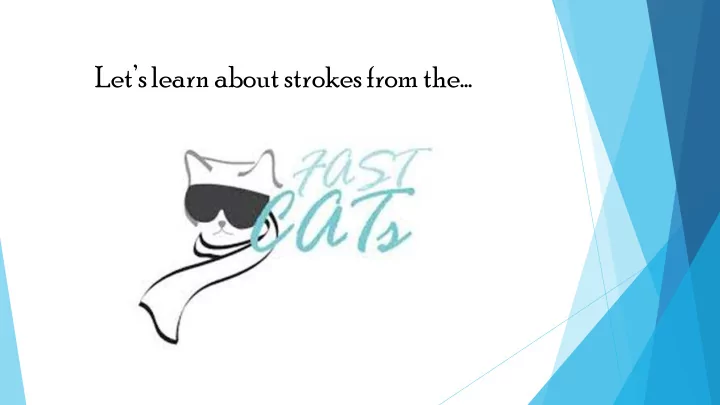

Let’s learn about strokes from the…
Objectives Discuss the FAST campaign for recognizing stroke symptoms Discuss the role of nursing in the care of a possible stroke patient Review the process of performing the NIH stroke scale
-Facedrooping -Armweakness -Speechdifficulty -Timeto call 911
Face drooping?
Arm weakness?
Speech difficulty? Slurred speech Expressive aphasia Aphasia
What do I do first? Room immediately Assess ABCs Last known well time Blood Glucose Head CT (goal <10 minutes of ED arrival)
Then what? Critical Care Assessment (doctor & nurse) Two large bore IVs/Labs VS Complete NIH stroke scale
TPA exclusion criteria checklist
Alteplasedosing Accurate weight in kg Bolus dose: 0.09mg/kg (Max 9mg). Give over 1 minute Infusion dose: 0.81mg/kg (Max 81mg) Give over 1 hour
After TPA infused… Neuro checks every 15 minutes VS every 15 minutes (Keep BP <185/110) Bleeding assessment every 15 minutes Monitor for angioedema every 15 minutes
NIHSS Assessment tool that helps to measure stroke-related neurologic deficit. Used to evaluate stroke acuity. Predictor of both short and long term outcome of stroke patients. Data collection tool for planning patient care. Provides a common language among healthcare providers. Administered at the bedside consistently by physicians, nurses or therapists. Requires less than 10 minutes to complete.
NIH Stroke Scale 1a. Level of Consciousness 1b. Level of Consciousness Questions 1c. Level of Consciousness Commands
NIH Stroke Scale 2. Best Gaze (horizontal plane) 3. Visual Fields (quadrants) 4. Facial Palsy
NIH Stroke Scale 5. Motor arm 6. Motor Leg 7. Limb Ataxia 8. Sensory
NIH Stroke Scale 9. Best Language 10. Dysarthria 11. Extinction and Inattention (formerly Neglect)
NIHSS Demonstration
References http://medical-dictionary.thefreedictionary.com https://stroke.nih.gov/documents/NIH_Stroke_Scale.pdf http://www.nihstrokescale.org/ http://www.stroke.org/understand-stroke/recognizing-stroke/act-fast
Have you ever had that day….. The NSP (night shift problem) became the DSP (day shift problem). It all started off with the WWI (walking while intoxicated) became the FTF (failure to fly) when HBC (hit by a car) and is complaining of TBP (total body pain) now that he is SOB (sober, out of beer). While this guy is BVA (breathing valuable air), he still LOFD (looks ok from the door) as you hurry on to your next patient…. The next patient FOWC (fell out of wheel chair) and now is HTK (higher than a kite) secondary to the dilaudid and performed a TUBE (totally unnecessary breast exam) on the nurse. Back to the NSP now a DSP: He is experiencing HDLT (high drama, low trauma), when asking about his meds he replies “WTF”: (wed-thurs-Friday)…what were you all thinking??? A little while later… a new patient is LOL FOF (little old lady found on the floor) who initially had smurf syndrome (cyanotic) but is better. She loves FMPS (fluff my pillow syndrome) and is requesting the TTJ (transfer to Jesus), you tell her she is not CTD (Circling the drain or certain to die) because Jesus isn’t quite ready yet.
Recommend
More recommend